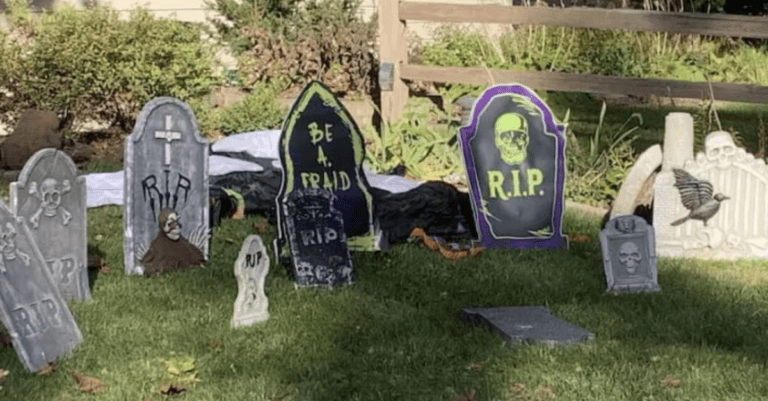When autumn begins in the northern hemisphere, people often decorate their businesses and homes to get ready for Halloween. In 2021, the National Retail Federation said Americans would spend a whopping $3.2 billion on Halloween decorations that year, so as you can imagine (or as you may have seen in your own neighborhood) these decorations can be quite elaborate. You often see mummies, witches, skeletons, spiders, jack-o-lanterns, black cats, cobwebs, ghosts, and tombstones. Or are they headstones? Or gravestones? Is there a difference? Does it even matter?
The words tombstone and gravestone used to refer to large stone slabs that served as a lid for a tomb or covering for a grave. They might have had engravings on them, but their purpose was to secure a deceased body in a tomb or in the ground. “Gravestone” is the older word, being used from the late 1300s, and “tombstone” is from the mid-1500s. A headstone, as the word implies, referred to a grave marker placed at the head of a grave. It’s the newest of the three words, arising in 1676, according to the Oxford English Dictionary.
Today, the words tombstone, gravestone, and headstone are often used interchangeably to refer to stone grave markers of any size or style. Regardless of which term you use, all three words refer to something made of stone that marks where someone is or will be buried. Sometimes cemeteries have grave markers showing where people who are still alive will be buried someday, but most grave markers indicate where someone has already been buried. So, whether they are being used to designate the location of a present grave or future grave, all three words — “tombstone,” “headstone,” and “gravestone” — refer to the same thing: a burial site with a marker made of stone.
Other words are also used to refer to grave markers. For example, the word “monument” is a common term for something marking an individual grave or a family plot containing multiple graves. In some cemeteries, it is common to see a large monument with a family’s name on it surrounded by smaller grave markers for the family members who are or will be buried there. Some gravesites also have a footstone, which, as the word implies, is a stone marker placed at the foot of a grave. Footstones are usually smaller and have fewer engravings than markers placed at the head of a grave. In some areas, such as New Orleans, Louisiana or in the famous Recoleta Cemetery in Buenos Aires, Argentina, you will also see aboveground vaults where bodies are interred. These elaborate resting places are also sometimes called tombs or mausoleums.
Etymonline has an interesting origin for the word “mausoleum”: It comes from one of the Seven Wonders of the ancient world, a “tomb … built in 353 B.C.E. at Helicarnassus (a Greek city in Asia Minor),” the ruins of which are in the present day city of Bodrum, Turkey. This massive marble structure — it’s believed to have been 48 feet high — got its name, the Mausoleum at Helicarnassus, from the name of the powerful ruler who was buried there: Mausolos.
Not all tombs are massive; graves and grave markers come in many shapes, sizes, and materials. The burial site of Edward Schieffelin provides an interesting example.
In the 1870s, Ed Schieffelin was a prospector trying to strike it rich. He ventured out alone in a rough, dangerous area east of the San Pedro River in Arizona Territory in search of rocks containing precious metals. A friend told him that the only rock he would find would be his tombstone. Ed knew what his friend meant, but he persisted and eventually found silver in several places. He named one of his strikes “Tombstone,” and when miners flocked to the area, the town that sprang up took on that same name. So, even though Tombstone, Arizona, is famous, or maybe that should be infamous, for a gunfight at the O.K. Corral involving Wyatt Earp and Doc Holliday on October 26, 1881, the town got its name from Schieffelin’s success, not from death in the Wild West.
Ed Schieffelin died in Oregon in 1897 but per his wishes, his final resting place is in Arizona. His grave near Tombstone is under a pyramid-shaped monument built of rocks and fashioned after the way that prospectors marked their claims.
The three casualties of Tombstone’s notable gunfight are buried in Boothill Graveyard along with others who lived, and died, in that place and time. Many of the early grave markers at Boothill were wooden crosses that disintegrated, and the graveyard fell into disrepair in the 1920s, but there were also some stone markers, and locals have restored the graveyard as much as possible.
Regardless of the material, shape, or size, the term “grave marker” can be used to refer to anything marking a grave. However, if a monument, or other memorial, even though it might look like a grave marker, is not marking a person’s actual grave, then it would be called a cenotaph, which comes from Greek that means “empty tomb.” War memorials inscribed with soldiers names, for example, are cenotaphs.
But all this still leaves us with the question of what to call those Halloween decorations that look like grave markers, but actually aren’t and might not even be made of stone. Because the words “tombstone,” “headstone,” and “gravestone” are commonly used as synonyms, it doesn’t really matter which term you use for their replicas in Halloween displays. Whichever word you use, people likely will understand what you are referring to, just as Ed Schieffelin knew what his friend meant with his warning that he would find his tombstone.
Image courtesy of Brenda Thomas.



